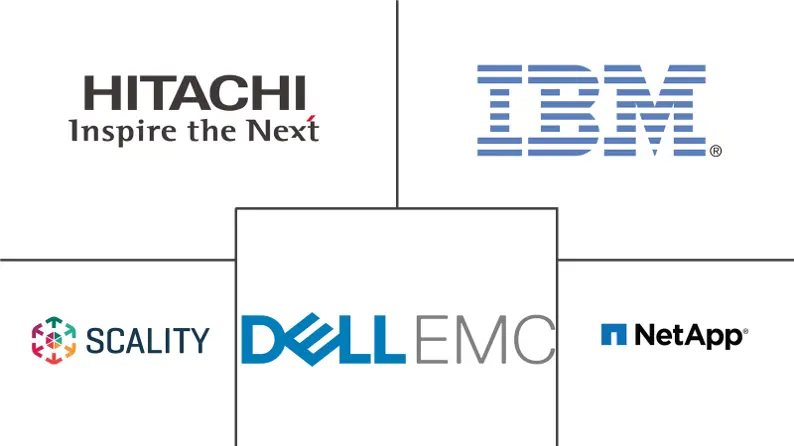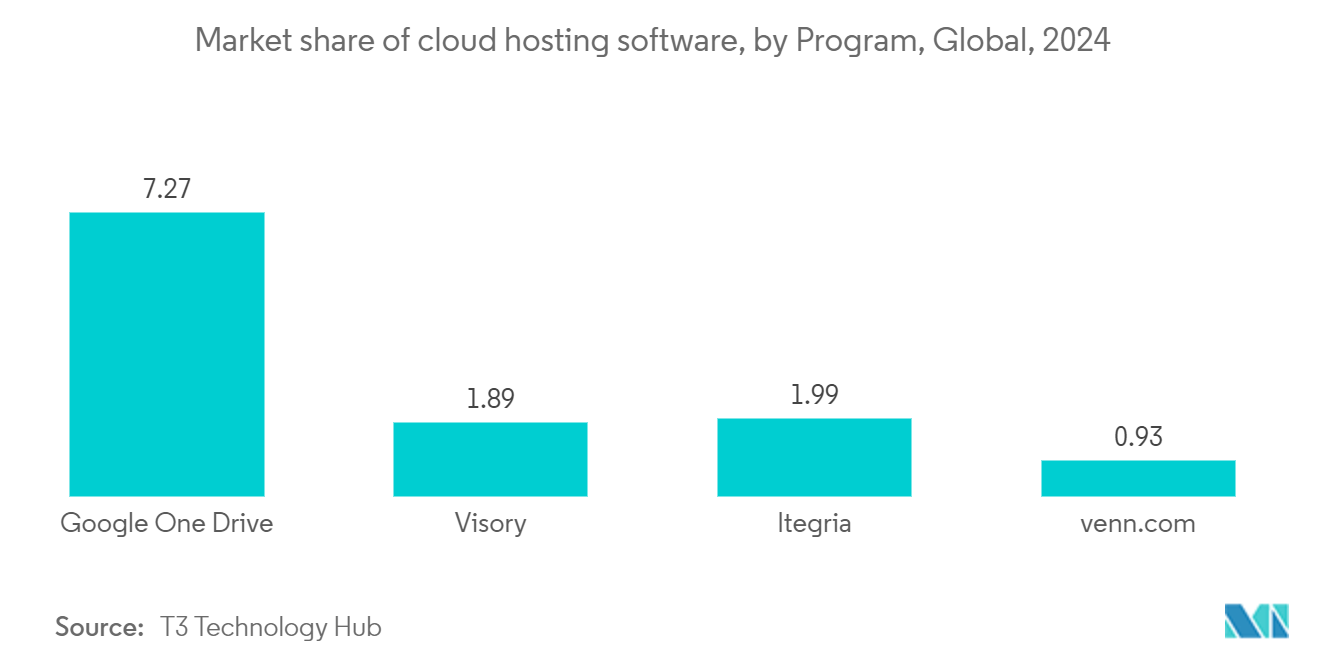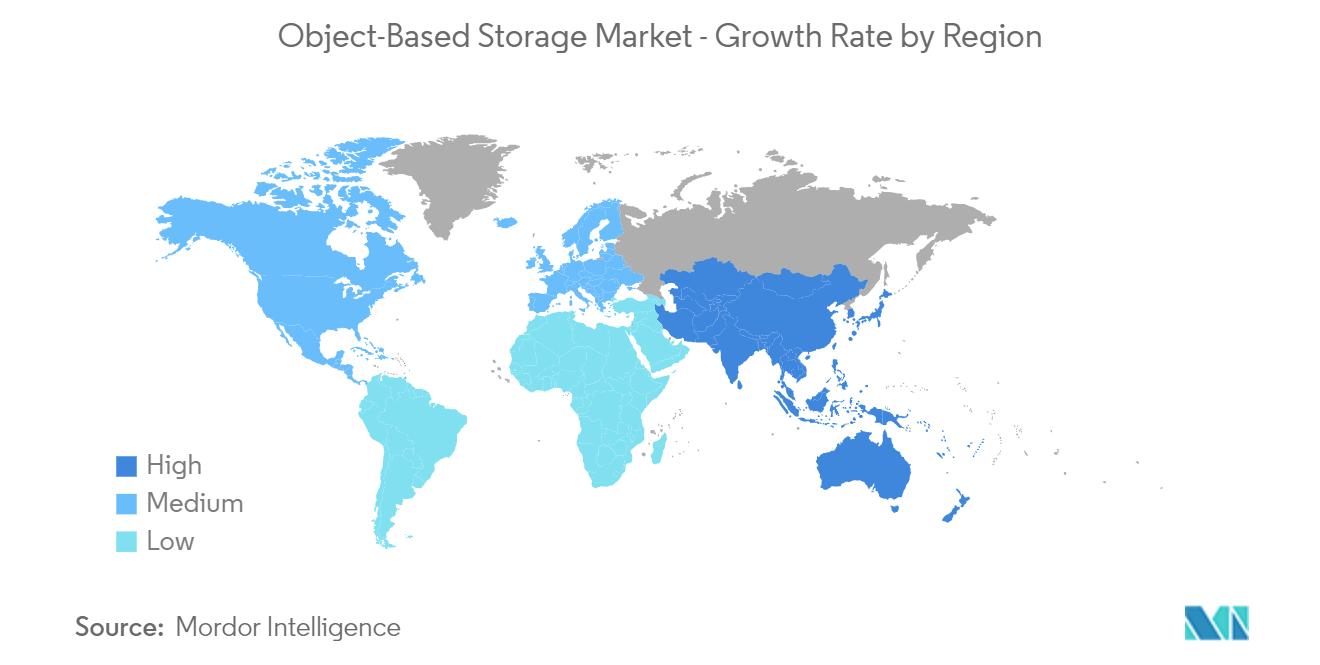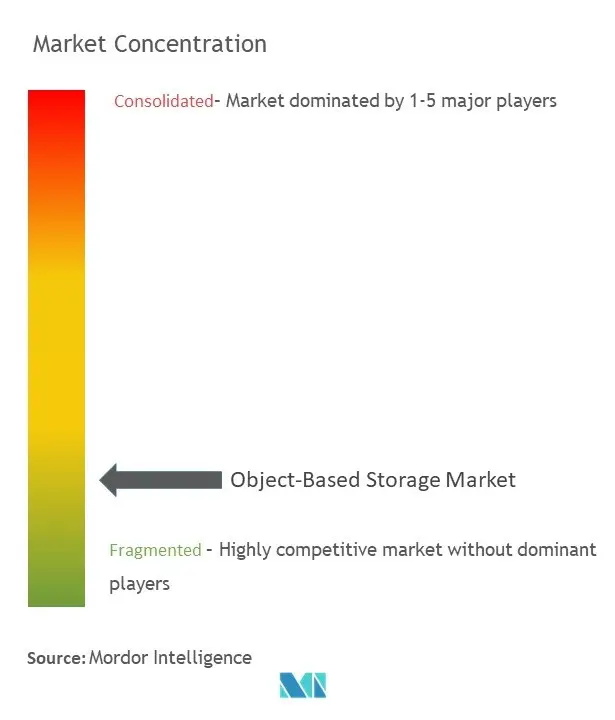Object-Based Storage Market Size

| Study Period | 2019 - 2029 |
| Base Year For Estimation | 2023 |
| CAGR (2024 - 2029) | 12.00 % |
| Fastest Growing Market | North America |
| Largest Market | North America |
| Market Concentration | Low |
Major Players
*Disclaimer: Major Players sorted in no particular order |
Object-Based Storage Market Analysis
The Object-Based Storage Market is expected to register a CAGR of 12% during the forecast period.
In contrast to conventional storage architectures like file systems, which manage data as a file hierarchy, and block storage, which manages data as blocks inside sectors and tracks, object storage is a type of computer data storage that maintains data as objects.
- The storage market is evolving to address new challenges in enterprise IT, such as exponential data growth, rapid digitalization and globalization of business, and requirements to connect and collect everything. Storage infrastructure systems based on object storage are growing significantly in both the number and capacity of deployments and are becoming the platform of choice to address the growth of unstructured data in enterprise data centers.
- The steep growth of unstructured data for emerging and established workloads requires products driven by infrastructure software-defined storage that can deliver tens of petabytes of storage and potentially leverage hybrid cloud workflow with public cloud IaaS. New and established storage companies are developing scalable object storage products to address cost, agility, and scalability limitations in traditional scale-up storage environments.
- Most organizations use a mix of storage types: file storage, block storage, and object storage. But the use of object storage is surging for several reasons: speed, scalability, searchability, security, data integrity, and reliability.
- Object storage provides various benefits for organizations that want to aggregate vast amounts of data, essential layer applications on top of that data store, conduct advanced data analytics that drives innovation, and protect against ransomware attacks.
- Several companies in the market for object storage are offering mixed deployment options to give customers choices in how they deploy infrastructure. Standard deployment options include turnkey high-density appliances or software-only options deployed on bare-metal industry-standard hardware as virtual machines or on docker containers. Companies in this market are increasingly offering their products as software-defined storage pre-certified to run on x86 industry-standard hardware.
Object-Based Storage Market Trends
Cloud based Deployment to Dominate the Market Share
- The steep growth of unstructured data for emerging and established workloads requires products driven by infrastructure software-defined storage that can deliver tens of petabytes of storage and potentially leverage hybrid cloud workflow with public cloud IaaS. New and established storage companies are developing scalable object storage products to address cost, agility, and scalability limitations in traditional scale-up storage environments.
- The current unstructured storage market is evolving to embrace hybrid cloud workflows and capabilities as IT leaders are looking to take advantage of public cloud agility, efficiency, and cloud computing capabilities. The object storage segment is considered a two-sided market. There are multiple providers of object storage protocols and consumers of these protocols consisting of applications.
- There were several providers than consumers until the Amazon S3 API became the de facto standard for object storage. Also, companies utilizing object storage platforms in enterprise data centers adopted Amazon S3, a protocol prominently used in the public cloud, because of the developer community around it.
- Several providers and consumers are using Amazon S3. Utilizing public cloud services like AWS has brought significant customer awareness to the object storage market. Software developers building Mode 2 web and mobile applications sometimes must repatriate these applications back to enterprise data centers. Enterprise IT seeks control of data and applications, while software developers seek efficient ways of programmatically interacting with infrastructure.
- Object storage excels at data sharing and consistency compared to other storage options. One instance of an application may wind up seeing partial data produced by another example in block-based and file-based data storage. Application developers ultimately require persistent locks to work around this problem. However, such plans have their own unique set of problems, including performance and accuracy issues.

North America to account for significant market growth.
- North America is expected to expand the global market through the projected period. The region's cloud object storage market is anticipated to grow throughout the review period due to the regional main players' consolidation. Additionally, the region's use of cloud storage services by large and small & medium organizations has increased due to the region's large-scale influx and outflow of enormous data.
- One of the factors driving the market's expansion is the growth of internet traffic and user-generated content, and the North American area sees the most I.P. traffic internationally. Cisco projects that the region's I.P. traffic will grow by 21% annually to 108.4 EB by last year.
- Additionally, the area is home to several well-known vendors in object storage, including IBM and Dell. This element aids in the greater use of Object-based storage in the area. Compared to unified file/block, SAN, and NAS, object storage will be purchased by more U.S. businesses. A quarter is expanding on-premises storage, while nearly half are boosting cloud storage.
- The BFSI industry is forced to adapt and innovate its services due to the change in business strategy. Worldwide, banking service providers are implementing cloud storage solutions. More than 90% of financial institutions, according to the American Bankers Association, use cloud technology for some or all of their banking operations.

Object-Based Storage Industry Overview
The object-based storage market is fragmented and fairly competitive and consists of several players, with a few major players currently dominating the market. Many companies are working on this technology due to its numerous advantages over other storage options. Some major players are Hitachi Vantara Corp, NetApp Inc., IBM Corporation (Red Hat), Scality Inc., and Dell EMC. Some of the recent developments include that, in
- November 2022, in collaboration with Snowflake, a provider of data clouds, Cloudian announced the opening of its HyperStore on-premises data lake storage. Customers of Cloudian and Snowflake will now have access to data deployed on-premises in a private cloud or hybrid cloud configuration and kept on HyperStore. HyperStore offers the scale and simplicity of a public cloud inside a company's data center, delivering improved performance, complete control over security, data sovereignty, and lower cost. HyperStore was created from the ground up to be fully S3 compliant.
Object-Based Storage Market Leaders
-
Hitachi Vantara Corp
-
NetApp Inc.
-
IBM Corporation (Red Hat)
-
Scality Inc.
-
Dell EMC
*Disclaimer: Major Players sorted in no particular order

Object-Based Storage Market News
- April 2024: Quantum has launched the ActiveScale Z200, an all-flash object storage appliance, to assist customers in managing the challenges posed by AI and big data workloads. As the newest addition to the ActiveScale series, the Z200 delivers an all-flash solution that greatly enhances throughput and transactional performance on a large scale.
- January 2024: Quantum Corporation, a firm in unstructured data solutions, announced that Amidata, a prominent managed services provider, has chosen Quantum's ActiveScale object storage as the cornerstone for its newly launched Amidata Secure Cloud Storage Service. Following the success of its Backup-as-a-Service and File Sharing Service offerings, built on Quantum's DXi backup appliances and StorNext file systems, Amidata has now integrated ActiveScale object storage.
Object-Based Storage Market Report - Table of Contents
1. INTRODUCTION
- 1.1 Study Assumptions and Market Definition
- 1.2 Scope of the Study
2. RESEARCH METHODOLOGY
3. EXECUTIVE SUMMARY
4. MARKET DYNAMICS
- 4.1 Market Overview
-
4.2 Industry Attractiveness - Porter Five Forces
- 4.2.1 Bargaining Power of Suppliers
- 4.2.2 Bargaining Power of Consumers
- 4.2.3 Threat of New Entrants
- 4.2.4 Intensity of Competitive Rivalry
-
4.3 Market Drivers
- 4.3.1 Low acquisition costs of object-based solutions (especially for large-scale storage)
- 4.3.2 Technological advancements such as multi-cloud data management and introduction of ML In storage analytics
-
4.4 Market Challenges
- 4.4.1 Resistance to Change From the Traditional Storage Practices
- 4.5 Comparative Analysis of File vs Block vs Object-based storage
- 4.6 Key Use-cases for Object-based Storage - Big Data, Web-apps, Backup Archives, Fraud Prevention, etc.
- 4.7 Impact of COVID-19 on the market
5. MARKET SEGMENTATION
-
5.1 Type
- 5.1.1 Cloud-based
- 5.1.2 On-Premise
-
5.2 Geography***
- 5.2.1 North America
- 5.2.2 Europe
- 5.2.3 Asia
- 5.2.4 Australia and New Zealand
- 5.2.5 Latin America
- 5.2.6 Middle East and Africa
6. COMPETITIVE INTELLIGENCE - KEY VENDOR PROFILES
- 6.1 Hitachi Vantara Corp*
- 6.2 NetApp Inc.
- 6.3 IBM Corporation (Red Hat)
- 6.4 Scality Inc.
- 6.5 Dell EMC
- 6.6 Cloudian, Inc.
- 6.7 Caringo Inc.
- 6.8 StorageCraft Technology Corp
- 6.9 WesternDigital Corp
- 6.10 SwiftStack Inc.
- 6.11 SUSE
- 6.12 OpenIO (OVHcloud)
7. INVESTMENT ANALYSIS
8. FUTURE OF THE MARKET
** Subject To AvailablityObject-Based Storage Industry Segmentation
Object-based storage technology organizes data in a flat structure that can be retrieved in the same manner as the original data stored rather than in a hierarchical form. This report segments the market by its type (cloud-based, on-premise) and geography.
The object-based storage market is segmented by its type (cloud-based, on-premise) and geography (North America, Europe, Asia Pacific, and the Rest of the World).
The market sizes and forecasts are provided in terms of value (USD) for all the above segments.
| Type | Cloud-based |
| On-Premise | |
| Geography*** | North America |
| Europe | |
| Asia | |
| Australia and New Zealand | |
| Latin America | |
| Middle East and Africa |
Object-Based Storage Market Research FAQs
What is the current Object-Based Storage Market size?
The Object-Based Storage Market is projected to register a CAGR of 12% during the forecast period (2024-2029)
Who are the key players in Object-Based Storage Market?
Hitachi Vantara Corp, NetApp Inc., IBM Corporation (Red Hat), Scality Inc. and Dell EMC are the major companies operating in the Object-Based Storage Market.
Which is the fastest growing region in Object-Based Storage Market?
North America is estimated to grow at the highest CAGR over the forecast period (2024-2029).
Which region has the biggest share in Object-Based Storage Market?
In 2024, the North America accounts for the largest market share in Object-Based Storage Market.
What years does this Object-Based Storage Market cover?
The report covers the Object-Based Storage Market historical market size for years: 2019, 2020, 2021, 2022 and 2023. The report also forecasts the Object-Based Storage Market size for years: 2024, 2025, 2026, 2027, 2028 and 2029.
Object Based Storage Industry Report
Statistics for the 2024 Object Based Storage market share, size and revenue growth rate, created by Mordor Intelligence™ Industry Reports. Object Based Storage analysis includes a market forecast outlook to 2029 and historical overview. Get a sample of this industry analysis as a free report PDF download.



